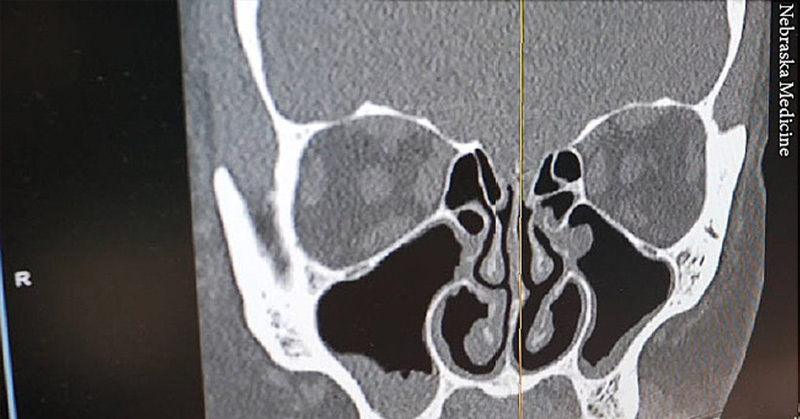This article was originally published in May 2018 and has since been updated.
Shortly after she sustained a severe head injury in a car accident, 52-year-old Kendra Jackson from Omaha, Nebraska, began to suffer some symptoms that the doctors misdiagnosed as ‘allergies’ or a ‘bad cold.’
She dealt with severe migraines, chronic nasal drainage, sneezing, and chronic coughing for the next two and a half years. The fluid was constantly dripping into her nose and mouth.
Speaking to CNN, she initially thought it was allergies herself and tried to wait it out [1]. When it persisted, she sought medical help that didn’t do much good.
“When it didn’t go away, I kept going back and forth to the doctors, and they prescribed every kind of medicine you can think of, and my nose just kept on running,” Kendra explained.

A CT scan ordered by rhinologist Christie Barnes, Kendra’s doctor at Nebraska Medicine, revealed the true cause of the woman’s suffering. A tiny hole in the outermost layer of her meninges (membranes that line the skull) was allowing Cerebrospinal Fluid (CSF) to drain into her nasal and buccal cavities. The condition is a rare one known as a Cerebrospinal Fluid leak, commonly called CSF leak [2]. Kendra must have sustained the tear or worsened it from the accident.
“Her description of the drainage that she had — it’s not typical for allergies,” Dr. Barnes said. “She would wake up in the morning and the front of her shirt was saturated with fluid. And she would have a gush of fluid — tablespoons of fluid — from her nose. So it was not just a nuisance drip that you’d get from allergies.”
The doctor explained that Kendra had been losing about 50cl of fluid every day.
Surgical reparation and recovery
After a series of tests and a CT scan, the diagnosis was confirmed. Dr. Barnes and another surgeon operated on Kendra to repair the damage by plugging the hole with abdominal fat.
“I went in through her nose, found the hole … and then I borrowed a small amount of abdominal fat and used that to create a fat patch to seal the leak, and over that I placed a piece of skin [from the] lining in her nose just to seal it,” Dr. Barnes said.
Barnes was happy to announce that Kendra had recovered in less than three weeks. It will take a while longer for the mild headaches to blow over, but the discomforting leak is no longer.
Speaking on how Kendra’s case story went massively viral, Barnes said:
“It is a little surprising,” she said. “But, from my standpoint [the case shows] a lot has changed over the years about how we treat leakages. What’s so exciting about this from a medical standpoint is we’re able to treat her with a minimally invasive procedure. That wasn’t true 10, 15 years ago.”
A quick review about CSF Leak
According to the CSF Leak Association, 5 out of every 100,000 people in the world suffer the condition yearly [3]. A CSF leak occurs when there’s a tear or a hole in the dura, the outermost layer of the meninges [2]. The dura is a thick membrane that contains the cerebrospinal fluid, which acts as a protective cushion for the brain and the spinal cord.
Reduction in CSF levels will cause a group of discomforting symptoms. A person will usually experience chronic nasal and buccal drainage, severe headaches and migraines, sneezing, pain in the neck, visual and auditory disturbances [4]. In severe cases, it can lead to tinnitus, spasms, and seizures. Diagnosis is usually confirmed by CT and MRI scans.
There are no medications for treating CSF leak. Medications may only be administered to manage the symptoms and keep them at bay. The tear is usually allowed to heal on its own, especially if it’s very small. This course of action might lead to meningitis, an inflammation of the protective membranes around the brain [5].
Corrective surgery is usually recommended. This is also the immediate course of action to be taken if the tear is a large one.
Sources
- https://time.com/5270817/nebraska-woman-cerebrospinal-fluid-leak/
- https://www.hopkinsmedicine.org/neurology_neurosurgery/centers_clinics/brain_tumor/center/skull-base/types/csf-leak.html
- https://www.csfleak.info/
- https://www.cedars-sinai.org/health-library/diseases-and-conditions/c/cerebrospinal-fluid-leak.html
- https://www.mayoclinic.org/diseases-conditions/meningitis/symptoms-causes/syc-20350508

